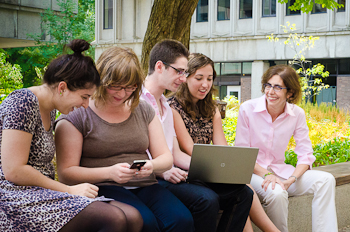Law and Education students confront cyberbullying with a pioneering project aiming to help kids “Define the Line” at which online pranks become criminal.

On the first day of school this year, new anti-bullying legislation went into effect in classrooms throughout Ontario and Quebec. Bill 13, the Accepting Schools Act, and Bill 56, the Act to prevent and stop bullying and violence in schools, are two of many similar laws in North America seeking to take a tough stance on cyberbullying, in response to public outcry over recent cases of suicide by targeted teens.
Too often, however, this type of anti-bullying legislation will “miss the mark,” according to cyberbullying expert Shaheen Shariff, a professor at McGill’s Faculty of Education who has conducted over 10 years of extensive research on the subject and now directs “Define the Line” (DTL), an interdisciplinary project involving several students of the Faculty of Law. With its outreach programs, research projects and recently relaunched website, the DTL project aims to draw the ethical and legal limits of online expression.
The new, more interactive, bilingual site is the work of the entire DTL team. It runs articles by Courtney Retter (BCL/LLB 2011), who has been involved with the project for some time, as well as second-year law student Laura Crestohl, who manages DTL’s social media accounts, and graduating law student Anna Piekarzewski who helps DTL explore issues of privacy and its intersections with social networking, online anonymity, and the challenges of identifying and addressing online harassment.

They are joined by four 2L students also working as research assistants for DTL: Thang Nguyen, a Political Science/History grad, is looking at criminal liability; Silvia Neagu, who also has degrees in education, French and literature, is researching the potential impact of constitutional and human rights law on cyberbullying; Alyssa Wiseman, a graduate of McGill’s psychology program, offers DTL her experience with survey methodology and data analysis; and David Plotkin, who has a sociology degree, researches issues in tort law and extra-contractual obligations in relation to cyberbullying. “They all have quite different backgrounds,” says Professor Shauna Van Praagh, who is involved in some aspects of the program and helped select the wide-ranging group, “which makes for a really interesting team of law assistants.”
Together, the interdisciplinary team aims to do many things with DTL. In addition to apprising students, parents and educators of the legal consequences for certain online behaviours, they are sketching out the existing legal frameworks that can be used to regulate cyberbullying, including tort law and criminal law, and mapping the emergence of new, anti-bullying legislation across North America.
In addition, DTL has been awarded a substantial SSHRC grant, as well as one of the inaugural “Digital Citizenship Research” Facebook grants, to research how children and teens experience cyberbullying, what they understand to be responsible online behaviour, and where they see the line, if any, between public and private spaces online. According to the preliminary research, Shariff and team have detected “a disturbing trend among digital natives” (those who have grown up with digital media as an integral part of their lives, as opposed to “digital immigrants,” like their parents), whereby at least 60% fail to clearly distinguish the difference between harmless teasing and harmful threats.
That’s where Define The Line comes in. Through their website and outreach programs, the DTL team aims to teach young people to recognize the point at which practical jokes cross over into cyberbullying, causing serious harm for which perpetrators are legally liable, be it through libel, slander, defamation, sexual harassment, possession of child pornography, or through emerging pieces of legislation that could criminalize cyberbullying per se.
“The issue of cyberbullying provides an ideal forum for exploring the intersections of formal and informal norms, actions, and consequences,” says Van Praagh. “In other words, a great place for thinking in a dynamic and diversified way about law.”
-Bridget Wayland
